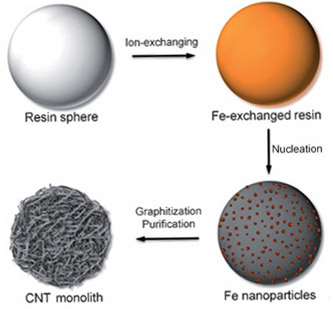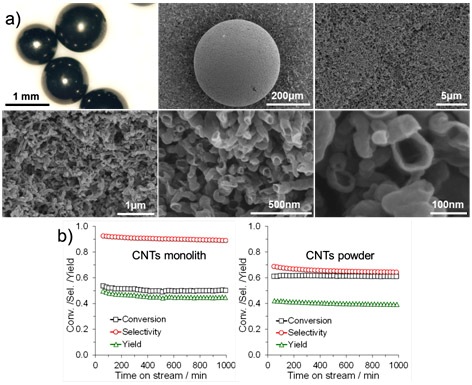The chemical-vapor-deposition (CVD) process is usually utilized for the large-scale production of carbon nanotubes (CNTs). In a typical process, the gaseous hydrocarbon feedstocks decomposed on metal catalyst under 700-1100oC, and the resulted carbon atomic nucleus self-organized into carbon nano materials with hollow tubular structure, which are attached on metal catalyst surface. The loose powder like CNTs prepared from CVD technique often exhibit low density, and which makes the following purification and handling process (washing, drying, shaping, etc.) very difficult. In addition, the CNT powders can not be used as catalyst or support for practical application, since they could block the reaction bed and lead to a great pressure drop, which limits the mass and heat diffusion in the reactor and brings serious safety risks to the entire process. One of the possible methods to solve above problems is the immobilization of CNTs onto other porous materials with well defined shapes (active carbon, carbon fiber, silicon carbide etc.). However the composite catalysts are generally not stable enough for practical applications due to the weak interactions between CNTs and supports.
The research team of Prof. SU Dangsheng and ZHANG Jian from Catalysis and Materials Devision (Shenyang National Laboratory for Materials Science) and Prof. XIAO Fengshou from Zhejiang University focused on the development of new method for the synthesis of monolithic CNTs since 2008. To solve the problems exsited in the catalytic application of CNT powder, they have developed a novel strategy for the production of CNT monoliths as millimeter-scale spheres through the graphitization of an ion exchanged resin, and the resulted CNT spheres exhibit excellent catalytic activity and high selectivity for styrene in ethylbenzene oxidative dehydrogenation reactions. The whole process of CNT growth has been conducted in a flow of ultrapure N2, avoiding the usage of alkanes, which is flamable and dangeous under high temperature. The graphitization degree of the resulted CNT spheres are relatively high even at low temperature (400~800 oC), and the bulk density of them is arround 0.55-0.91g mL‑1. The CNT sphere catalysts exhibit high catalytic activity, reliable safety and low energy cost in oxidative dehydrogenation reactions, which should promote the practical applications of CNTs in catalysis. The related research results are published on Angewandte Chemie International Edition 2012, 51, 7581.
The breakthrough of this original research is that: 1) for the first time, CNT monoliths with definite shape are produced directly through the combination of ion exchange and solid state CNT growth process; 2) multiple advanced insitu characterization techniques are used to analysis the changes of iron and carbon species during CNT growth process; 3) the detailed comparison between CVD and solid state CNT growth mechanism provides a complete understanding of the metal–carbon interactions governing the formation of a carbon nanostructure, which facilitate the large-scale production process of CNTs. The research results from Prof. SU Dangsheng and his coworkers (Science, 2008, 322, 73; Angew. Chem. Int. Ed., 2010, 49, 8640; ChemSusChem, 2010, 3, 169) revealed that carbon nano materials exhibit a relatively high activity in dehydrogenation or oxidative dehydrogenation catalytic reactions, which demonstrate their potential to replace traditional metal or metal oxide catalyst in practical applications. The above research results solve the serious problems for the shaping of CNT catalyst, and promote the practical applications of CNTs in catalysis. This work was supported financially by MOST (2011CBA00504) and NSFC (21133010, 50921004).

Figure 1, Schematic representation of the synthesis of CNT monoliths (Image by IMR)

Figure 2, Microscopic images (a) and catalytic activity (b) of CNT sphere monoliths. (Image by IMR)